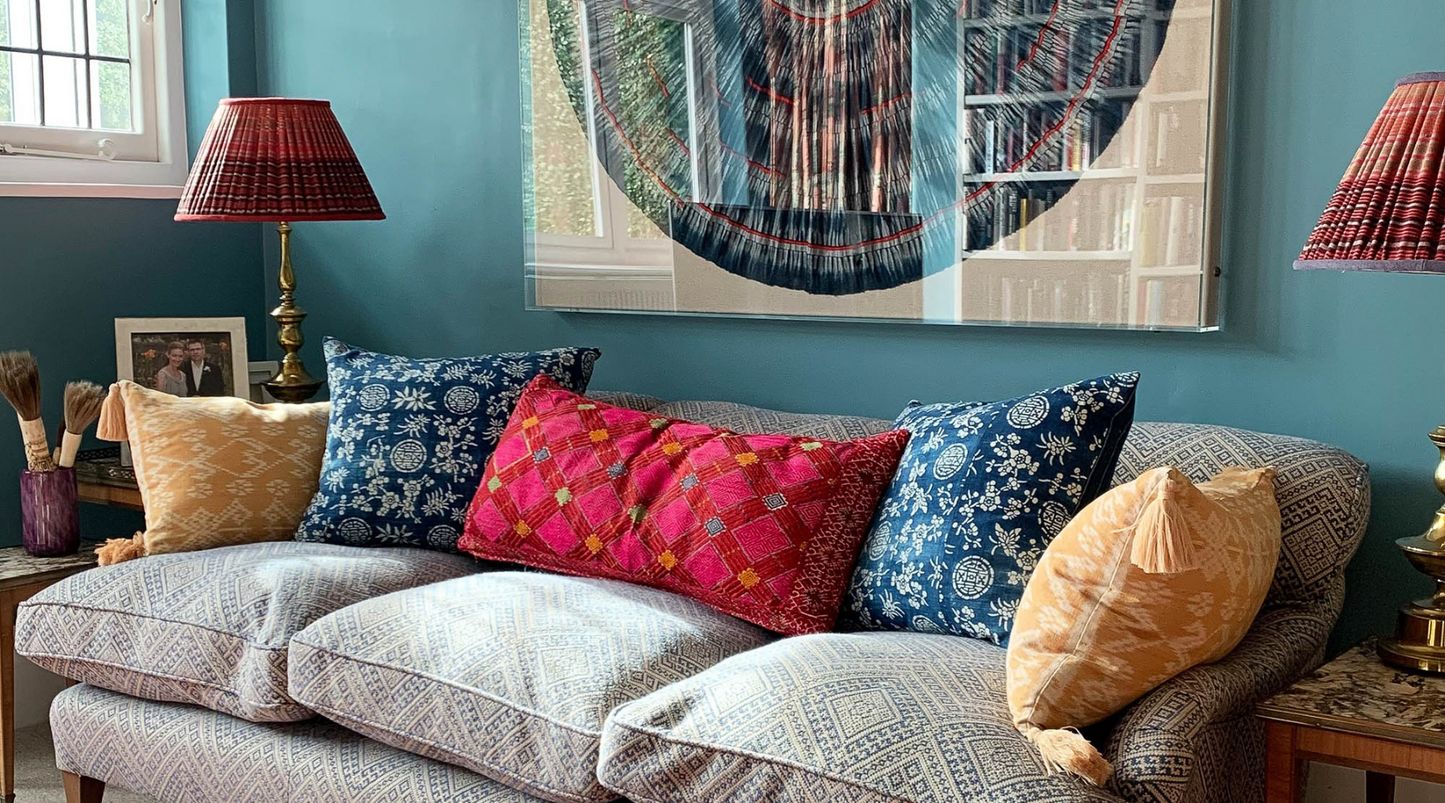
Penny Worrall is a fountain of knowledge and expert in sourcing stunning Vintage Woven Textiles from around the world. From simple European hemps crafted by dedicated farmers to the intricate dowry textiles woven by talented women in the Chinese Minority groups; each piece is a testament to the richness of human craftsmanship and ancestral stories.
Penny masterfully and conscientiously transforms these wonderful textiles into beautiful pieces for the modern home, such as stunning cushions and lampshades, as well as utilising them as striking pieces of wall art. Here Penny generously shares some of her fascinating knowledge of textiles with us...
How do you go about incorporating them into your work?
I make home furnishings from vintage global textiles, so it's my customers and clients that incorporate them into their interiors. I sell through my website, two selling platforms and Instagram and try to use photography to inspire customers. I’m also happy to collaborate with clients on larger projects, whereby I will make cushions to fit the style of the interior design scheme.
How best to display them?
This will depend on the textile: robust textiles usually make good cushions or best used in upholstery. If it is a fragile, rare or valuable textile then it would be better framed for wall art. Very large textiles could be used to dress beds/windows or for upholstery such as seating, headboards or ottomans.
Where to start when using vintage textiles? Can they inspire a whole scheme?
I think its better to start from somewhere rather than nowhere and a loved textile is a great starting point. Robert Kime famously started his schemes from a carpet. I used a hill-tribe migration skirt for my living room scheme and have just bought a Kurdish hall runner that has the most beautiful colours that I am picking out for my new kitchen.
Unique creative ways of working with vintage textiles?
My love of textiles started at a young age where I would buy Laura Ashley remnants to make patchwork. I still love patchwork and incorporating textiles from the old clothes of a much-loved relative into patchwork is a wonderful way of preserving a memory. As would making soft toys, lampshades, book covers, cloth baskets; as anything that you would use a contemporary textile for, can also be utilised as a vintage textile.
Vintage textiles usually have a story and that gives an extra dimension to the end product. I work mainly with hand-loomed ethnographical textiles that have been made in some of the more remote parts of the world. Many of them have been used for blankets/clothing, made into clothing or form part of a bride’s dowry. The skills, the looms and the designs are being lost as the younger generations have no interest in learning them from their older relatives. Therefore reusing a vintage textile is a way of preserving it; so it can be admired and the narrative continued.
Some cultures such as the Miao Chinese minority will tell their ancestral stories going back thousands of years of through their textile designs. Older textiles tend to be coloured with natural dyes and these age to a wonderful soft palette that is sought after by interior decorators in this country.
I also have to mention that I have met some amazing and knowledgeable characters in the textile industry. They travel the world to find the textiles, bring them back to Textile Fairs here and are more than happy to share their knowledge and educate customers.
Why would you recommend for others to work with vintage textiles?
I think for all of the above reasons and using a vintage textile instead of a new one is better for the planet.
What would your top 3 tips be for anyone looking to start using vintage textiles?
Buy what you love, that way you should continue to like it. Condition is everything: hold a textile up to the light to check for small holes or insect damage. Be careful with washing as older dyes may not be colour fast.
How has the fabric and textile industry evolved since you became a part of it and what do you see and hope for the future of it?
I think its polarised. There is now a movement towards sustainability at the higher end of the market which is great. People have more knowledge about textile production. For example the production of cotton uses a lot more water than linen and there is a an increasing interest in the production of natural dyes. Some businesses are working towards B Corp certification for which they need to demonstrate a responsibility towards people and the environment.
However, at the bottom end there are brands that are flooding the market with cheap clothes, made with manmade fibres that are worn once and discarded. This is producing a real problem for landfill as these textiles don’t decompose.



